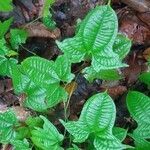Tuber perennial, becoming very large in age, depressed globose, flattened below, hollowed towards the centre, developing roundish lobes in age, up to 40 cm. in diameter and 15 cm. deep, the upper surface near ground-level.. Plant glabrous.. Twining stems 25 m. or more long.. Leaves normally opposite; petiole 8–12(–26) cm. long; blade heart-shaped, up to 20(–46) cm. long (including acumen) and 23(–58) cm. broad, with a thickened acute acumen 5(–20) cm. long; towards base of stem leaves replaced by fleshy auricles; leaf-blades of young plants variously shaped and lobed (see fig. 3/1–3).. Aerial tubers irregularly roundish, up to 6 cm. diameter, deep purplish.. Inflorescences pendulous, spicate.. Male 1 or 2 per leaf-axil or forming a terminal leafless panicle; spikes up to 50 cm. long, with 1 or 2 downwardly directed flowers at each node, not opening wide, ± 5 mm. long. Stamens 6.. Female inflorescences 1–3 per leaf-axil, up to 48 cm. long; flowers solitary at a node, directed downwards; perianth not opening wide, ± 3 mm. in diameter. Ovary ± 6 mm. long.. Capsule as in fig. 1/2, p. 4, ± 5 cm. long and 2.5 cm. in diameter, directed upwards.. Seeds (fig. 1/2a) winged at both ends, ± 3.5 cm. long.
A yam. The vine is 6-25 m high. The tubers occur singly and are rounded. They are 50 cm across. They are near the soil surface. The stems twine to the left. It does not have spines or only blunt, flattened spines. The leaves are opposite. They taper to the tip. The edges of the leaves are thickened and often roll inwards. The young leaves have 3-9 deep lobes. There are usually bulbils along the vine. These are up to 5 cm across. They are round but vary in colour and texture.
Glabrous non-spiny climber 15-20 ft. high
Bearing purple or brownish toxic bulbils
The perennial tubers are also poisonous
Female flowers white, veined purple.

